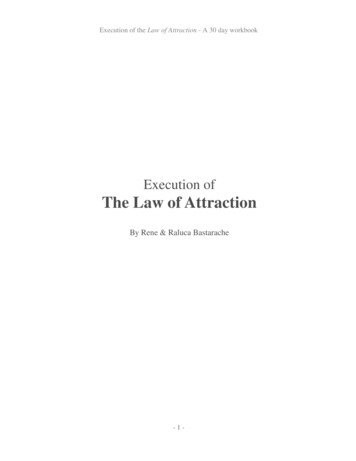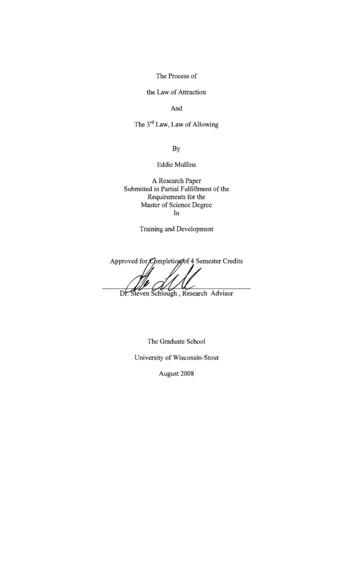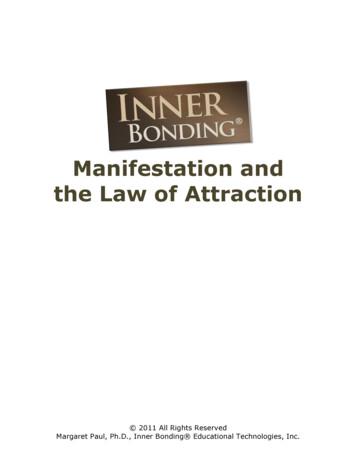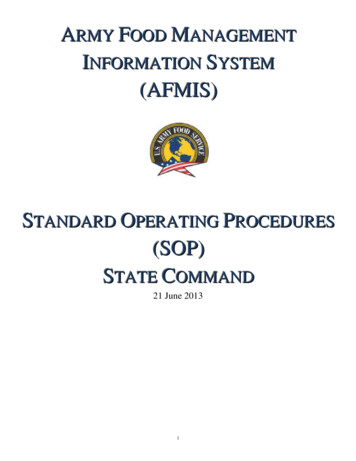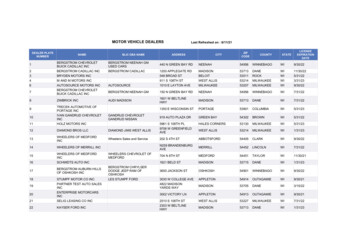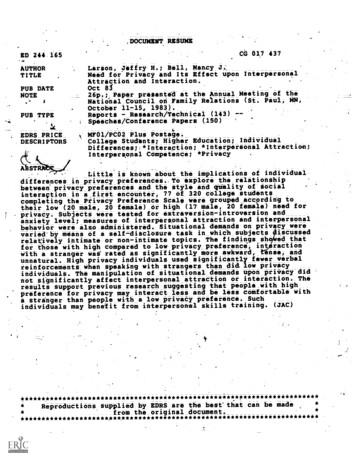
Transcription
DOCUMENT RESUMEED 244.165AUTHORTITLEPUB DATENOTE.3PUB TYPE.EDRS PRICEDESCRIPTORSCd 017 437Larson, Jeffry H.; Bell, Nancy J.Need for Privacy and Its Effect upon InterpersonalAttraction and Interaction.Oct 8126p.; Paper presented at the Annual Meeting of theNational Council on Family Relations (St. Paul, MN,October 11-154 1983).Reports - Research/Technical (143) -Speeches /Conference Papers (150),le01/PCO2 Plus Posta6;College Students; Higher Education; IndividualDifferences;*Interaction; *Interpersonal Attraction;Interpersonal Competence; *PrivacyA STLittle is known about the implications of individualdifferences in privacy preferences. To explore the relationshipbetween privacy preferences and the style and quality of Socialinteraction in a,first encounter, 77 of. 320 college studentscompleting the Privacy Preference Scale were grouped according totheir low (20 male, 20 female) -or high (17 male, 20 female) need forprivacy. Subjects were tested for extraversion-introversion andanxiety level; measures of interpersonal attraction and interpersonalbehavior were also administered. Situational demands on priv cy werevaried'by means of a self ditcloSure task in whieh subjects iscussedrelatively intimate or non intimate topics. The findings sh ed thatfor hose with high compared to low privacy praferenci, int ractionense, andWith a stranger was rated as significantly more awkward,unnatural. High privacy individuals used significantly fewer verbalreinforcements when speaking with strangers than did. Iow privacyprivacydidindividuals. The manipulation of situational demands Uponnot significantly affect interpersonal attraction or interactionTheresults support previous research suggesting that people with highpreference for privacy may interact less and be less comfortable witha stranger than people with a low privacy preference. Suchindividuals may benefit from interpersonal skills training. **************************Reproductions supplied by SEORS are the best'that can be madefrom the original ******************************
4-Need for Privacy and Its Effect Upon.inteTporsonal Attraction and InteractionbyJeffry H. LarsonMoatana State University."Nancy J. BellTexas Tech UniversityU.S. DEPARTMENT OF EDUCATIONNATIONAL INSTITUTE OF EDUCATIONEDUCATIONAL RESOURCES INFORMATIONUNTERIEMMXThis document has been reproduced asreceived from the person or organization"PERMISSION TO REPRODUCE THISMATERIAL HAS BEEN GRA TED BY1Originating it.Minor changes have been made to improvereproduction quality.Points Of view or opinions stated in this document do not necessarily represent odiCiaiNIEposition or policy.t41-TQ THE EDUCATIONAL RESOURCESINFORMATION CENTER (ERIC)."Send requests forreprints to Jeffry Larson, Assistant Professor of FamilyRelations, Montana State University, Bbzeman, Nbntanac c.0Running Head:Need for Privacy59717-
N eed for Privacy'1AbstraotThe present study explored the implications of variations in privacypreference:3 for the,quality and-style;of interpersonal behavior in an'initial encounter situation;The influence of sit uational variations inpriVacy upon interpersonal behavior was also examined.sized that:It was hypothe-(a).perions with a high preference for privy woad be lessattracted-to and interact less w- ith altranger than people with a law'preference; and,(b) differences between privacy preference groups (high'versus low) in attraction and interaction could be greater in a situation-which places high rather than low demands upon privacy:The research4design was a 2 (privacy preference) by 20situational demand) by 2(gender) design.Sittlational demands upon privacy were varied by meansof a selfdisclosure task in which-subjects discussed relatively intimateor non-intimate topics.The findings showed that/for those with high compared with lowprivacy preference, interaction with a stranger wadrated as simore awkward, tense, and unnatural.*ficantlyHigh privaby individuals verballyreinforced speakingby the strangers significantly less than low privacyindividuals.The manipulation of situational demands upon privacy did not.significantly affect interpersonal attraction or interaction.The resultsof this study support previgts 4esearch which has suggested that people withhigh preference for privacy may interact less and be less comfortable witha stranger than people with a low preferdnce.The implications of these find-ings for relationship developMent-and interpersonal skills training wasdiscussed.1
Need for Privacy2.4"Privacy can be defined as an outcome of'a person's wish to withholdfrom others certain knmiledge as to his/her past, present or ftiture :-experience and action lAltMan, 1974).Past research on privacy hasconcerned itself with chanyes in the defini.6.on of privacy as a functionof development (Wolfe & Laufer, 1974), changes in privacy preferencesas a result of environmental changes (Aloai, 1973,,Pastalan, 1979, & Wolfe& Rivlin, 1971), and the relationship between privacy preferences andantecedent envirorgental variables like family size and crowding; andalso personality variables (Marshall, 1972).hasAnother group of studiesdealt with environmental/spatial variables like numberand size of-----bedrooms, room density (number of people in a roomr square foot) andtheir relationship to.perceived privacy (Park, 1979; Smith; et al, 1979).Little is known about the implications of individual differences inprivacy preferences for the way people structure their social interactions,the implications of privacy preferences for effectiveness in interper.sonal interactions.It has been"generally assilmed that privacy should beprotected and that invasion of privacy may cause psychological harm andlead to impaired interpersonal functioning (Altman, 1974; jourard, 1966).HOWeVer,.the relationships between privacy preference, privacy invasion;and social interaction have, not beendetermined:On one hand, it ispossible that privacy. preferences reflect primarily a need to controlthe amount of social interaction rather than affecting the quality ofsocial interaction.Alternatively, as suggested by samecorrelates of preferred privacy (Marshall, 1972), intand skills may also be associated with need for privacy.f the personalityrsonal style andMarshall (19/2)
Need fOr privacy3found that people with a high need for privacy when conpaaed to those witha low need for privacy tended to be introverted rather than extraverted,logical and analytic ratheethan sympathetic and feeling, to have littledesire for inclusion in groups, and to express or need little affection.These personality correlates'of privacy preferences suggest that privacypreference might affect the quality of social interaction.It i8 also likely that situational demands on privacy influencethe duality of interaction, and that this is true to a greater extent forthbte with high compared with low privacy preferences.Beardsley (1971);GtbSt (1971), and Pennock and Chapman (1971) consider violations ofprivacy as potentially hartful because they can threaten individual-.-autonomy, self respect,- and in a sense demean the worth'of a persOn:Coffman (1961)and Jourard (1966) pointed to the critical effect of a mentalpatient's privacy on self-identity and self-esteeM.The present study was designed to explore (a) the relationship betweenprivacy prelferences and the style and quality of social interaction inadyadic, first encounter situation, and (b) the influence of situationalvariations in privacy upon social interaction.Based upon the correlatesof privacy preferences identified by Marshall (102) and upon the implica-tions of privacy preference for interpersonal behavior from the discussionof Goffman (1961) and Jourard,(1966), it was anticipated that indiVidualswith high privacy preferencecompared with those having loW preferenceswould express less attraction for a stranger and would be rated as less competent in interaction skills.Further, it was anticipated that privacypreference level would int.Pract with situational demands 41pOti ptivacy such
,.;Need for Privacyti4that differences in social interaction between highand low privacy1preference groups would be greater following an intimate self disclosuretask than following a noninpimate self disclosure task. This predictionwas based upon thepresUITtion that a greater.amount of discomfort andanxiety would be experienced by persons with a high need for privacy, compared to low need for privacy in an intimate self disclosure task.:In summary, the hypotheses were:1.Persons with a high need for privacy will exhibit less attractionfor a stranger, a lower level of interaction with a stranger, and lesscompetence in social skills than persons with a low need for privacy.2.Differences between privacy preference groups in attraction for1;--a stranger and social interaction will be greater in a situation whichplaces high compared with low demandS uppnvacy.tSubjectsA.SUb)ects for this4study were-77 undergraduate stUdents attendingintroductory family relations courses at Texas Toth University.ono-group 20 mile, 20 'female) consisted of . individuals with a law need forprivacy, and another incT62ed indiViduals with a high need for privacy,2Q females).Of a total of 320 stUdents dbMpleting the PrivadyPreference Scale (PPS), the 40 scoring the highest on the PPS were placed inthe high-need for privacy group (2iNin 340.60, S.D. 10.97), the 40 loweststudents were plteed"in the low-need for privacy groupS.D. 11.30).( 276.40EThree male students in the highineed for privacy group4re unable to participake in the study;
Need for Privacy,5.Measures-A,,rivacy preference. Students'were tested/Using-the Privacy PreferenceScale (PPS) developed by Marshall (1972);This scale is the only one ofits kind for use in-measuring.privacy preference;-.72 (coefficient alpha).(Marshall, 1972);It has a reliability ofThq PPS consists of 93 itemspresented as.a summative scale with five response alternatives for eachitem ranging from strongly agree to strongly disagree;six sUbscalcs:Nighborinq; Seclusion,. Solitude,. Anonymity, Reserve, and0Intimacy.Extraversion-introversion.0The scale includesBecause infrioversion is related boa high-11'need for privacy (tshall, 1972) and low interpersonal interaion (Myers,1964, the Extraversion-Introversion (E-I) subscale of the Myers-BriggsType Indicatpr (M-BTI) was Oiministered so that scores would be.aVdilablefor use as a covariati.The E -I subscale of the M-BTI is designedtomeasure ease in .40 liking for interpersonal contact.Slit-half re l.agility (Spearman Brown formula) for the E-I subscale is .8l.A test' retestcorrelation of .70 has been reported (Myers-Briggs, 1962).Anxiety level.In a situation which places high demands on privacy an:individual should experience more anxiety than irk a lowdemand situation. .In order to measure the'level of anxiety after the initial 5-minute periodsdescribed below, each per-Son completed the Affect Adjective Check List(MEV,'a 61-item quick measurement Scale of general anxiety reveal (Zuckerman, 1960).Internaf consittencrlfor this scale. is 72 (kuder-Richardbon Formula 20),and test-retest reliability is :85 (Zuckerman, 1960).
Need for PriVacy6Linterpersonal attraction and behavior measures.measure ofThe-interpersonal attraction was'an instrument consisting of 17- bipolaradjective dimensions (e.g., exciting-dull, genuine-artificial, friendly.unfriendly) developed by Icket and barneS i(1978) to measure.interpersonalattraction:Each individual was asked to rate the strangern thesedimensions,The person's ratings on each of the 17 adjective pairs wassummed to obtain a global index of attraction to'or liking of thQconfederate;The second questionndire was the Interpersonal JudgeMent Scale (IJS)(Byrne; 1971) which meadUi-es.a person's desire to have some futdre inter.,The two attraction items include the degree toaction with a partner.,which he/she would 'like to know the stranger better in theTheure.two items 4re measOrtle on a 7-point scale r- anging from 1,(mostnegative),tto 7 (most posite) and-are summed to constitute this measure of ihter-personaliattracByrne and Nelson (1965) reported a split-half''reliability on the scale of4.85.-,With rest to other verbal measures,.IJS attrac* ton responses.have been found to be negatively related to ratingsof:-Sbcial distan6e (Schwartz, 1966);Nonverbal indfces of attraction,including standing and seating proximity (Byrne, Baskett, & Hedges, 1971),anq visual interaction (Efida, 1969) were. also positively related to theIJS measure of attraction./pThei third treasure of. attraction was designed to assesslevel of satisfaction with his/her interaction;.person'sBased on a 21-p-int Scale.from "not at all" to "extremelyi"Jstudents were asked to answer thefollowing six questions taldthe perspective of both themselves J.3
r.Need for Privacy-opestiOns). and the Stranger (3 questions):(a)"To what degree did theinteraction swmawkwara, forced, and strained to (you/the other person)::"(b)"To what'degree did the interaction seem silcoth, natural, and relaxed(you/theothbr person) ?" and (c)"How much rapport did (you/the otherperson) feel with (the other person/you)?" An overall measure of s,-Itig4faction.with,the interaction was obtained by subtracting the twoAeon the first item from the sum of their ratings on the tratings of boththe second and 'third items.' In using the measure Ickes, eireported that the items Were'moderately intercorrelated (r12I.-.58 to 440 to ;48, r13 .22 to -.37);- .Interpersonal behavior in the. dyads was coded from videotaped. daBehavioral indices developed by Ickes and1Barnes (197gT for measquantity and quality.of interpersdnal 'interaction in same-sex dyads Was.used) These behavioral indicators included:.zation; (b)-frequppicy of ver(a) total duration of verbali--reinforcers that indicate attention to,.1 -unrizrstanding of, or. agre.nt
not significantly affect interpersonal attraction or interactionThe results support previous research suggesting that people_with high preference for privacy may interact less and be less comfortable with a stranger than people with a low privacy preference. Such individuals may benefit from interpersonal skills training. (JAC) ***** Reproductions supplied by SEORS are the best'that can be .
